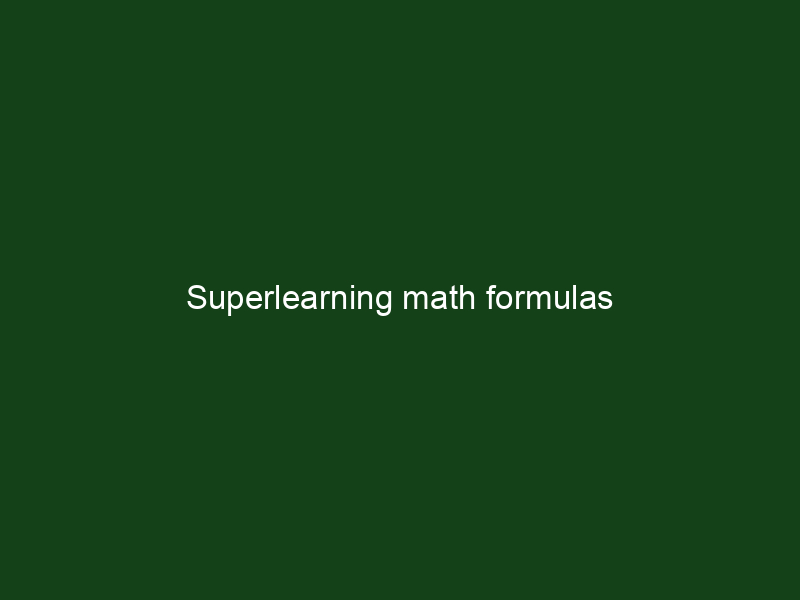Mathematical formulas are especially difficult to handle. Math is basically a different language that explains complex relationships between abstract objects. It makes no sense to visualize math as you would visualize history. My personal approach comes from data analytic and is graphical: there are various mathematical forces that bend graphs in various ways. Understanding why each graph bends the way it does is in the heart of mathematical superlearning – at least for me.
Question:
How do I speed-read and memorize math and formulas?
Answer:
There is no one commonly acceptable way to speed-read and memorize math, since there is no one kind of math. The first principle would be to adapt yourself to the particular type of math you study.
Math is an abstract language for describing complex relationships. Our brain did not develop to deal with abstract methods. One of the ways to attack this problem is remembering 2-3 characteristic examples and deducting the mathematical rule from them. These examples can serve as markers to more abstract formulas. So how do you generate and remember these examples? The scientists have readily available tools: tables, graphs, conclusions, discussions… Graph would be most convenient to remember as marker, so try to make graphs as much as you can, any sort of graphs including lines, pies, surfaces, bars – whatever works for you.
Usually math describes a complex idea. You do not get only one formula, but you get many. Some formulas like E=mc2 are beautiful, and they help to remember less beautiful formulas. Einstein perfected mental experiments as a way to memorize and understand stuff. Physics is easier to understand than pure path: there are units for everything, and any relationship is a result of physical processes that have a real-life meaning. You can use units and real-life ideas and mental experiments and beautiful formulas to as markers to remember whole theories.
There are also small specific tips you could use: keep table of symbols with cool visual markers for each, try WRONG formulas to see why you cannot make particular mistakes (see e.g. this blog and this video )… If you are lucky someone already have written a method specifically for you e.g. this .
As always practice makes perfect. Having a PhD in math, I read about 50 articles per day. If I am lucky 2-3 are really original, others just say the same things using different symbols and terminology. There is really nothing that can replace deep understanding and experience…
There was an interesting article regarding memorization of numbers: http://lifehacker.com/memorize-long-numbers-with-a-sentence-or-a-song-1543808448. In this course we made an emphasis on chunking methods since they are very fast to learn and use. However, you may find other methods more fun. Try them out. Enjoy.
How can I create markers for random dates and numbers? Do you always relate numbers to a specific memory? Is it always the same?
For example how can I remember January 29, 2004? Do I create a marker for each day, month and year?
Sure. Markers for numbers are either very generic or very personal. For generic numbers, there are mnemonic number systems. The oldest and simplest is probably http://en.wikipedia.org/wiki/Mnemonic_major_system. A very different generic system is described athttp://www.buildyourmemory.com/numbers.php.
Personally I do not like generic systems, since they look as too much work. An alternative is assigning meaning to numbers based on your own experience. For example 29 Feb is a very special day [happens every 4 years including 2004] and 29 Jan is just a month before. There was 29th of Feb in 2000 and the next after it was in 2004. It is easier to create markers if you add some semantic information, like what happened at 29Jan 2004: for example exploding whale in Taiwanhttp://en.wikipedia.org/wiki/January_2004. Then you get “a whale exploded on a second leap year of this millennium, one month before the leap”. I find little research in Wikipedia both fun and helping…
Try to find what works for you….
First of all thank you for offering this course – I am very excited about the idea of being able to become a better learner. One of the areas I am trying to improve in is mathematics. Now when I want to memorize a text like this:
- A polynomial has the form shown, where an is the leading coefficient of the polynomial, and a0 is the constant term of the polynomial. All of the polynomial coefficients must be real numbers.
I struggle to find any images for abstract concepts like “coefficient” . Also I wonder if there’s a way to memorize formulas with the marker technique. It would be great if you could give me an idea how to handle this kind of stuff.
Do not try to handle mathematical text as you would handle history….
For mathematics I typically visualize graphs.
Low-level: 2-dimensional graph
Medium level: Intersections between graphs, moving graphs controlled by other parameters, area under the graph (think of economic graphs)
High – level: Multidimensional manifolds (like in machine learning), graphs corresponding to pivot tables, graphs generated by attribute selection and stochastical gradient descent….
Do my math homework on Assigncode.com, that provides homework excellence in every technical assignment.

Get 4 Free Sample Chapters of the Key To Study Book
Get access to advanced training, and a selection of free apps to train your reading speed and visual memory

